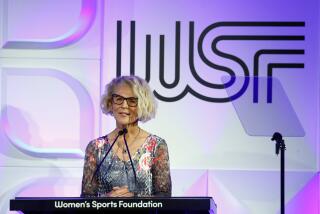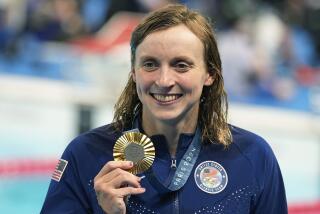Quance Finds Herself in Good Company : Swimming: Support of new teammates at Calabasas-based club spurs 16-year-old to world-class times in two events.
- Share via
The last time Kristine Quance appeared in the U. S. National Swimming Championships, in August, 1990, she was unknown and all alone, the sole member of the Valley Aquatic Club to qualify.
When she left Austin, Tex., five days later with bronze medals in the 200-meter breaststroke and the 400 individual medley, she had gained recognition as one of the rising stars in American swimming.
Eight months later, Quance, a Granada Hills High sophomore, rose to even greater heights. Her times in the spring national championships April 3-7 in Federal Way, Wash., rank her third in the world in the 200 breaststroke in 1991 and fifth in the world in the 400 individual medley. And this time Quance was not alone: She benefitted from the support of her new teammates at CLASS Aquatics.
“It is nice to have people to share it with and people who cheer you on,” Quance said. “Most everyone has a good attitude and it rubs off on everyone else.”
Quance left the Valley Aquatic Club and Coach Steve Reardon shortly after her performance in Texas for CLASS Aquatics and Coach Bud McAllister.
With Quance’s help, the Calabasas-based CLASS team earned its highest finish--eighth place--in the national championships.
Only five CLASS swimmers scored points, including Chris Baskett, Nikki Hudson, Jason Stelle and Alexis Larsen, but it was enough to put CLASS on the map in just 1 1/2 years under McAllister.
Quance picked up the lion’s share of the points with runner-up finishes in the 200 breaststroke and 200 and 400 individual medleys.
In the 200 breaststroke, Quance finished in 2 minutes 29.88 seconds, behind the star of the meet, American record-setter Anita Nall, who clocked a 2:27.08, the second-fastest time ever.
In the 400 individual medley, Quance clocked a 4:44.86 but was caught from behind by Janet Evans, the Olympic gold-medal winner in the event in 1988.
“I knew I didn’t have a big enough lead at the end of the breaststroke,” Quance said. “She is a freestyle maniac. I saw her at the first turn. Then she came up and passed me by. My legs were dead the last 25.”
It is progress, though. Last summer, Evans was two seconds ahead of Quance at the beginning of the freestyle portion.
Quance, 16, also finished fourth in the 100 breaststroke and seventh in the 200 butterfly.
Like her teammates, she improved dramatically in each event: by 4.66 seconds in the 400 individual medley and by 3.64 seconds in the 200 breaststroke
“I knew they’d swim fast because they’ve been swimming fast all year,” McAllister said. “We didn’t expect eighth-place, though, because we don’t have any relays. It is unique. The thing was that everyone swam fast. That usually doesn’t happen. Sixteen of our 17 swims were best times.”
Stelle dropped four seconds off his 200 backstroke time and two seconds off his 100 backstroke time for 14th- and 13th-place finishes. The 18-year-old Agoura High senior will attend USC on a swimming scholarship in the fall.
When McAllister took over the 12-year-old CLASS team, only one or two swimmers were senior national caliber.
By the summer version of the national championships this August, however, McAllister expects to have eight or nine swimmers meet the qualifying time standards.
At the junior national level, McAllister expects six more swimmers to make the qualifying time standards, increasing the number at that level to 10.
In addition to the enhanced quality, CLASS’ depth is increasing. The team will be 200 strong this summer, 50 more than when McAllister took over in August, 1989. McAllister, 34, came to CLASS after a brief stay with Team Orlando in Orlando, Fla. Before that he coached 3 1/2 years at Fullerton Aquatics, where Evans was his prize pupil.
Ironically, it was McAllister’s success with Evans that made Quance’s parents, Sandy and David, hesitate to ask him to work with their daughter.
“They said they would have brought her over earlier but they didn’t want me to turn her into a distance freestyler,” McAllister said. “I don’t want to be typecast as a distance-freestyle coach. It depends on who you have success with first. If I had Kristine first I would be known as a breaststroke coach, but I had Janet first.”
Quance realized that a change in teams was in order after her first international competition, the Legion of European Nations Cup in Rome last August. “At Valley, I used to do all the workouts by myself,” she said. “Then when I went to Rome it was a whole different story. There were lots of (U.S. team members) to push me.”
CLASS is a large and talented enough team that Quance can train for the individual medley with Baskett and Stelle, among others, and as a freestyler with Larsen and Hudson.
It was difficult to leave Reardon, however, because he had taken her so far. “He designed my breast-stroke especially for me, with my flexibility in mind and (because) I have long arms and legs,” said Quance, who stands 5-foot-8.
Quance’s style is to ride high in the water with half her torso out.
Her pull starts very wide and ends under her chin. Unlike some other top breaststrokers, her hands do not recover out of the water and she does not use her hips in a dolphin motion. “My kick is the weakest part of my stroke,” Quance said.
Another weakness was her conditioning. “Last year I went out (fast) and died at the end,” she said of the 200 breaststroke in summer nationals when Mary Ellen Blanchard and Jill Johnson passed her at the end. “This time, my second half was stronger.”
Quance’s workload increased, from one practice per day to two, making her rapid improvement somewhat predictable. Because of the diversity of strokes and the distance, McAllister expects to see even more improvement in the 400 individual medley.
But perhaps her best chance for a medal in the 1992 Olympic Games in Barcelona could come in the 200 breaststroke, a weak event for U. S. women the past four years.
“I see Anita (Nall) and Kristine with definite shots to win medals,” McAllister said. “They are both young and they can drop some more (in their times). Both are top five in the world right now so we’ll see what happens this summer.”
Because Granada Hills High was on spring break when Quance returned from Washington, few of her classmates know of her exploits.
“They are more interested in football and baseball,” Quance said. “It is so hard for people out of swimming to understand what I do, and I don’t expect them to.”
Nor does she need them to, not since she has found teammates at CLASS who can help push her toward her Olympic dream.
More to Read
Go beyond the scoreboard
Get the latest on L.A.'s teams in the daily Sports Report newsletter.
You may occasionally receive promotional content from the Los Angeles Times.






